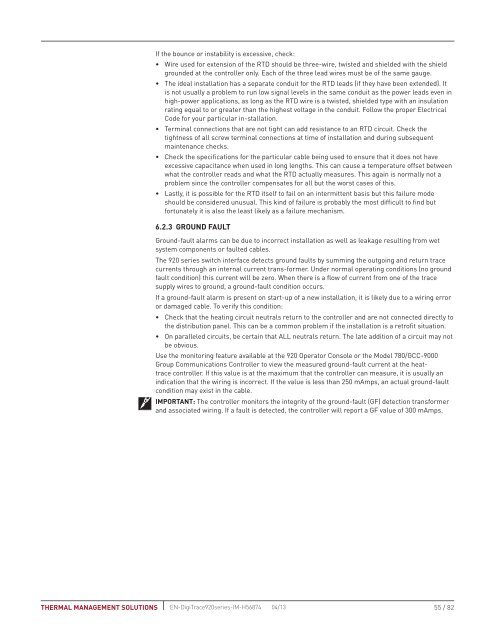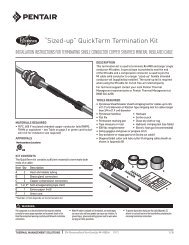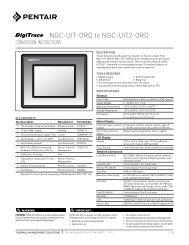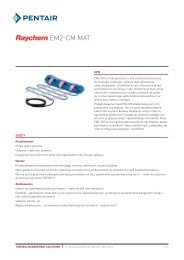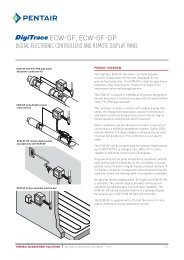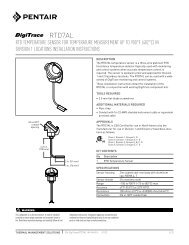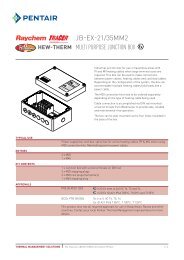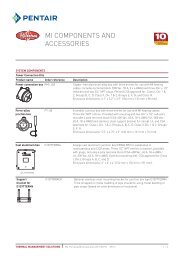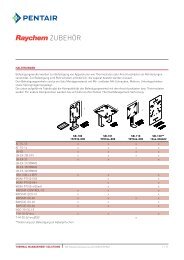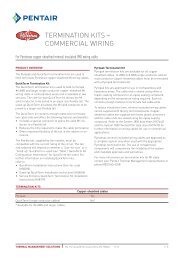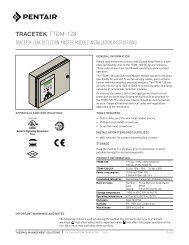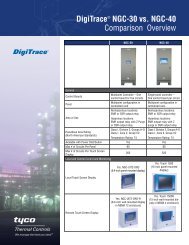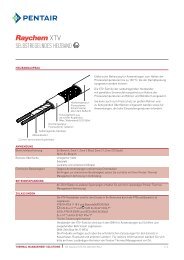DigiTrace 920 Series Heat Trace Controller - Pentair Thermal ...
DigiTrace 920 Series Heat Trace Controller - Pentair Thermal ...
DigiTrace 920 Series Heat Trace Controller - Pentair Thermal ...
You also want an ePaper? Increase the reach of your titles
YUMPU automatically turns print PDFs into web optimized ePapers that Google loves.
If the bounce or instability is excessive, check:• Wire used for extension of the RTD should be three-wire, twisted and shielded with the shieldgrounded at the controller only. Each of the three lead wires must be of the same gauge.• The ideal installation has a separate conduit for the RTD leads (if they have been extended). Itis not usually a problem to run low signal levels in the same conduit as the power leads even inhigh-power applications, as long as the RTD wire is a twisted, shielded type with an insulationrating equal to or greater than the highest voltage in the conduit. Follow the proper ElectricalCode for your particular in-stallation.• Terminal connections that are not tight can add resistance to an RTD circuit. Check thetightness of all screw terminal connections at time of installation and during subsequentmaintenance checks.• Check the specifications for the particular cable being used to ensure that it does not haveexcessive capacitance when used in long lengths. This can cause a temperature offset betweenwhat the controller reads and what the RTD actually measures. This again is normally not aproblem since the controller compensates for all but the worst cases of this.• Lastly, it is possible for the RTD itself to fail on an intermittent basis but this failure modeshould be considered unusual. This kind of failure is probably the most difficult to find butfortunately it is also the least likely as a failure mechanism.6.2.3 GROUND FAULTGround-fault alarms can be due to incorrect installation as well as leakage resulting from wetsystem components or faulted cables.The <strong>920</strong> series switch interface detects ground faults by summing the outgoing and return tracecurrents through an internal current trans-former. Under normal operating conditions (no groundfault condition) this current will be zero. When there is a flow of current from one of the tracesupply wires to ground, a ground-fault condition occurs.If a ground-fault alarm is present on start-up of a new installation, it is likely due to a wiring erroror damaged cable. To verify this condition:• Check that the heating circuit neutrals return to the controller and are not connected directly tothe distribution panel. This can be a common problem if the installation is a retrofit situation.• On paralleled circuits, be certain that ALL neutrals return. The late addition of a circuit may notbe obvious.Use the monitoring feature available at the <strong>920</strong> Operator Console or the Model 780/GCC-9000Group Communications <strong>Controller</strong> to view the measured ground-fault current at the heattracecontroller. If this value is at the maximum that the controller can measure, it is usually anindication that the wiring is incorrect. If the value is less than 250 mAmps, an actual ground-faultcondition may exist in the cable.IMPORTANT: The controller monitors the integrity of the ground-fault (GF) detection transformerand associated wiring. If a fault is detected, the controller will report a GF value of 300 mAmps.THERMAL MANAGEMENT SOLUTIONS EN-<strong>Digi<strong>Trace</strong></strong><strong>920</strong>series-IM-H56874 04/1355 / 82


